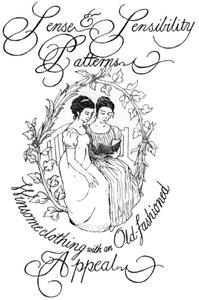Fitting Help for Miss Petite
If you are usually a size 0 or 2 in off-the-rack sizes and have a petite frame (particularly if you are narrow through the shoulders with a measurement of less than 15" from shoulder to shoulder), you will need to make some adjustments to your bodice pattern pieces to obtain a perfect fit. If you go by your bustline measurement when choosing a size, you are likely to end up with a gown that either gapes badly in the front neckline or that slips off one shoulder.This section is here to help you alter any pattern to give you a beautiful fit every time. [Note: Illustrations on this page show the Regency Gown bodice, but the steps given will work on any bodice. If you're making a bodice with darts rather than gathers, you'll just check the fit by pinning in the darts rather than pulling up basting stitches to gather.
Making a Toile
I cannot emphasize strongly enough the importance of making a toile for a try-on before you cut out your fashion fabric. A toile is simply a garment or partial garment constructed from muslin or another inexpensive material. In this case, you'll need to make a bodice for your fittingóno need to add sleeves or anything else. Baste together the pieces, then enlist the aid of a helper to pin the bodice closed in back (the overlap should be 1" to allow for the seam allowance and overlap on the final gown). Do note that it is vital that you try on your toile over the undergarments you intend to wear beneath your gown!
But What About My Size?
My general rule of thumb for Miss Petite is this: If your bustline measurement indicates that you need a size 10, you should make your toile in a size 8. Just go a size down from whatever your bustline measurement indicates and create your toile from that size. Then you can proceed to the step-by-step instructions for fitting your toile. This will help you circumvent many narrow shoulder fitting issues from the get-go.
Fitting and Making Adjustments
Once your toile is basted together, put it on over your undergarments and have a helper pin it closed in back as explained above. Standing in front of a mirror, check to make sure the side seams of the bodice come directly below the underarm (if you are wearing a set of stays or a petticoat beneath, you can actually pin the side seam of the toile to the side seam of the undergarment to anchor it). Also check to make sure the armholes are comfortable (keeping in mind theyíll be larger once the sleeves are sewn in). Going down a size may mean you need to trim out a wee bit at the bottom of your armhole. If you do cut down the armholes, be sure to use a sleeve in the next size up.
Now take a good look at the shoulders of the bodice. The outside edge should extend past your shoulders by 5/8î (the seam allowance for the sleeve). If the shoulders are drooping or falling down, youíll need to adjust them by bringing them in closer to the neckline. For now, just write down how far toward your neck the shoulders need to move. When you are ready to make the change to your master pattern, you will create an ìLî-shaped slash like the one shown in ìAî below, then move the entire armhole area in toward the neckline to take up the amount youíve noted (ìBî). Repeat this step for the bodice back piece. (Making these changes will also take up any slack in the neckline if you have gaping issues there.)
Before you check the fit of the bustline, it is best to go ahead and make a new toile with the changed shoulder area. If you didnít have to make any changes to the shoulder, then just continue on. Pull up the basting stitches below the bustline on each side to take in the fullness that will be gathered into the skirt front when you make your gown. Now check to make sure there is room enough in the bodice to accommodate your bosom. Essentially, there should be no pulling horizontally across the bust, and the bodice should be long enough so that the bottom hits you below the bustline, leaving enough room for your seam allowance and a comfortable fit. If there is any pulling or binding horizontally, you will add to your side seam as shown in ìAî below. If the bodice seems too short, note down how much length you need to add to it (this is also true for ladies with a low bust point, by the way). Change your master pattern as shown below.
Finally, take a good look at your neckline to make sure you like where it is hitting you. Do keep in mind that you will ìloseî 5/8î all the way around the neckline of your gown when it is sewn to the lining. You can make changes to the neckline of your master pattern by simply following the curve line indicated, marking it either higher or lower, depending on your own needs:
Once youíve got your master pattern marked and adjusted, go ahead and cut out the lining of your gown and sew it together. Use this as your final toile to check the fit one last time. If youíre happy with what you see, congratulations! Youíre ready to start on your gown. If you find youíre still running into some fitting concerns, be sure to visit Why Doesn't This Look Like the Pattern Cover? for additional fitting helps for ladies of all shapes and sizes. No one has a ìstandardî body, so fitting a toile to create a master pattern is a big accomplishment that will guarantee success in all your sewing endeavors!

